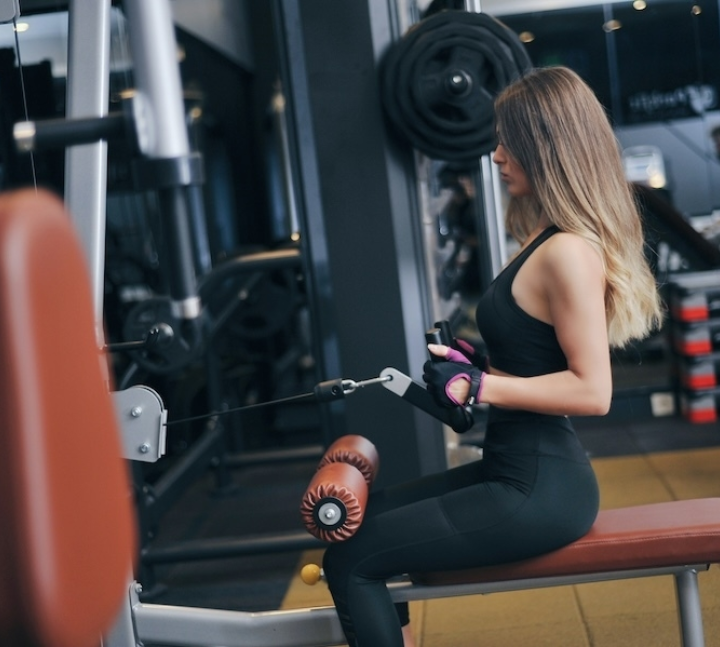Exercise
Lever Seated Row
How to Perform - Lever Seated Row
- Adjust the seat height so your chest aligns with the handles and your feet rest flat on the platform or floor.
- Grasp the handles with a neutral grip (palms facing each other) and sit tall with your chest up and shoulders pulled back.
- Extend your arms fully without rounding your shoulders forward, maintaining a slight bend in your elbows.
- Brace your core muscles and inhale deeply before initiating the movement.
- Pull the handles toward your torso by driving your elbows back, keeping them close to your sides while exhaling steadily.
- Squeeze your shoulder blades together at the end position, bringing the handles to your lower ribs or abdomen.
- Hold the contracted position momentarily, focusing on the engagement of your middle back muscles.
- Return the weight to the starting position in a controlled manner while inhaling, maintaining your upright posture throughout.
Important information
- Keep your back straight and avoid leaning backward excessively during the pull to prevent lower back strain.
- Focus on pulling with your back muscles rather than your arms by visualizing your elbows leading the movement.
- Adjust the weight to allow for complete control throughout the full range of motion—if you can't maintain form, reduce the load.
- Ensure your chest stays pressed against the pad throughout the exercise to stabilize your spine and isolate the target muscles.
Primary Muscles
Muscle Groups
Mechanic
Risk Areas
Built for progress
Take the guesswork out of training
Create personalized AI-powered workout plans that evolve with you. Train smarter, track every rep and keep moving forward, one workout at a time.






The Lever Seated Row stands as a cornerstone back exercise in any comprehensive bodybuilding regimen, particularly targeting the latissimus dorsi and trapezius muscle groups with remarkable efficiency. This intermediate-level movement has earned its reputation among strength enthusiasts and physique competitors alike for its ability to build impressive back thickness and width simultaneously.
What makes the Lever Seated Row particularly valuable is its fixed path of motion, allowing lifters to focus purely on the contraction rather than stabilizing a free weight. This mechanical advantage enables greater time under tension specifically for the lats and traps, making it an excellent choice for bodybuilders seeking detailed muscular development through targeted isolation.
While appearing straightforward, mastering the Lever Seated Row requires attentiveness to form nuances that distinguish casual gym-goers from dedicated strength athletes. The exercise serves as an excellent progression for those who have established foundational back strength and are ready to emphasize specific muscle groups with greater load and control. Many experienced lifters incorporate this movement into their training splits, typically performing it for moderate to high repetitions to stimulate hypertrophy.
From a strength development perspective, the Lever Seated Row allows for substantial loading potential while minimizing stress on the lower back compared to bent-over row variations. This makes it particularly valuable for those looking to build pulling power without compromising spinal integrity. The stability offered by the chest pad enables lifters to channel their energy into pure pulling force rather than balance maintenance.
When programmed effectively within a bodybuilding routine, this exercise can transform back development by creating the coveted thickness through the mid-back region. The versatility of the Lever Seated Row makes it suitable for both strength-focused mesocycles and higher-volume hypertrophy blocks, earning its place as a mainstay in training programs designed for both aesthetic enhancement and functional strength development.
FAQ - Lever Seated Row
The Lever Seated Row primarily targets the latissimus dorsi (lats) and trapezius muscles, while also engaging the rhomboids, rear deltoids, and biceps as secondary movers. This compound pulling movement effectively builds thickness throughout the entire mid-back region.
Sit with your chest firmly against the pad, grasp the handles with a neutral grip, and pull directly toward your torso while keeping your spine neutral. Focus on driving your elbows back rather than using momentum, and fully extend your arms at the starting position without rounding your shoulders forward.
Include the Lever Seated Row 1-2 times weekly within your back or pull training days. For hypertrophy, aim for 3-4 sets of 8-12 repetitions with moderate weight; for strength development, consider 3-5 sets of 6-8 repetitions with heavier loads.
Avoid bending your elbows to compensate for limited shoulder mobility, as this negates the stretching benefits. Don't rush through repetitions or use momentum—move slowly and deliberately. Also, never force the movement beyond the point of mild discomfort, as this could lead to shoulder strain.
The Lever Seated Row is generally safer for those with lower back issues compared to bent-over row variations, as the chest pad provides stabilization. However, consult with a healthcare provider first, maintain strict form, start with lighter weights, and avoid jerking movements that could aggravate existing conditions.






